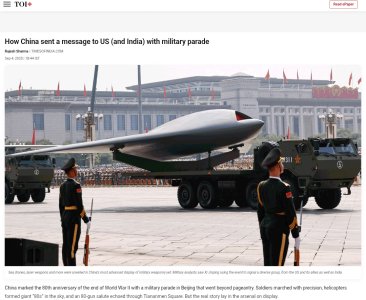- Joined
- Nov 25, 2023
- Runs
- 23,408
@Rajdeep loving your Chini friend now 
====
China hosted a major military parade in its capital, Beijing, on Wednesday, marking 80 years since the end of World War II.
In the country’s largest ever military parade, President Xi Jinping welcomed world leaders, including Russian President Vladimir Putin and North Korean leader Kim Jong Un, presenting China’s military prowess and vision for the future. Also present was Kim Jong Un’s teenage daughter and possible heir, Kim Ju Ae, who made her first known international trip to China for the parade.
Here is what happened during the parade.
The last time China hosted a Victory Day military parade was 10 years ago. That was also the first time China had organised a grand military parade to commemorate the end of the war.
What happened during the parade?
It was a presentation of Chinese military might, comprising a choreographed showcase of advanced military equipment such as drones, hypersonic missiles and fighters.
China unveiled nuclear-capable missiles that can be launched from land, sea, and air simultaneously – marking the first public display of its complete “triad” of nuclear-ready capabilities. This included the Jinglei-1, an air-based, long-range missile; Julang-3, a submarine-based intercontinental missile; and Dongfeng-31 and Dongfeng-61, land-based intercontinental missiles.
China also presented the Yingji-17, Yingji-19, and Yingji-20, which are hypersonic antiship missiles that China has tested against prototypes of US aircraft carriers.
Also on display were drones with the ability to function underwater, as well as in the air, some of which are intended for reconnaissance missions and precision strikes. Additionally, unmanned helicopters designed for ship-based launches were featured in the parade.
Cruise missiles, Changjian-20A, Yingji-18C, Changjian-1000, and hypersonic missiles Yingji-21, Dongfeng-17, and Dongfeng-26D also appeared during the event.
The parade also featured a performance by a military band and choir.
Prior to the parade, state media reported that 80 buglers would be performing, marking the 80 years since the defeat of imperial Japan in World War II. State media also reported that more than 1,000 musicians would be seated over 14 rows, representing each year of China’s resistance following Japan’s invasion of Manchuria in 1931.
Xi made a speech addressing 50,000 spectators at Tiananmen Square. “Today, mankind is faced with the choice of peace or war, dialogue or confrontation, win-win or zero-sum,” said Xi, adding that the Chinese people “firmly stand on the right side of history”.
He wore a suit akin to those worn by Mao Zedong, who led the Chinese Communist Party (CCP) to victory during the civil war post-World War II.
Spectators were seated on chairs coloured green, red and gold, which symbolise fertile land, the sacrifices of the people, and peace, respectively, according to China’s state broadcaster, CCTV.

 www.aljazeera.com
www.aljazeera.com

====
China hosted a major military parade in its capital, Beijing, on Wednesday, marking 80 years since the end of World War II.
In the country’s largest ever military parade, President Xi Jinping welcomed world leaders, including Russian President Vladimir Putin and North Korean leader Kim Jong Un, presenting China’s military prowess and vision for the future. Also present was Kim Jong Un’s teenage daughter and possible heir, Kim Ju Ae, who made her first known international trip to China for the parade.
Here is what happened during the parade.
The last time China hosted a Victory Day military parade was 10 years ago. That was also the first time China had organised a grand military parade to commemorate the end of the war.
What happened during the parade?
It was a presentation of Chinese military might, comprising a choreographed showcase of advanced military equipment such as drones, hypersonic missiles and fighters.
China unveiled nuclear-capable missiles that can be launched from land, sea, and air simultaneously – marking the first public display of its complete “triad” of nuclear-ready capabilities. This included the Jinglei-1, an air-based, long-range missile; Julang-3, a submarine-based intercontinental missile; and Dongfeng-31 and Dongfeng-61, land-based intercontinental missiles.
China also presented the Yingji-17, Yingji-19, and Yingji-20, which are hypersonic antiship missiles that China has tested against prototypes of US aircraft carriers.
Also on display were drones with the ability to function underwater, as well as in the air, some of which are intended for reconnaissance missions and precision strikes. Additionally, unmanned helicopters designed for ship-based launches were featured in the parade.
Cruise missiles, Changjian-20A, Yingji-18C, Changjian-1000, and hypersonic missiles Yingji-21, Dongfeng-17, and Dongfeng-26D also appeared during the event.
The parade also featured a performance by a military band and choir.
Prior to the parade, state media reported that 80 buglers would be performing, marking the 80 years since the defeat of imperial Japan in World War II. State media also reported that more than 1,000 musicians would be seated over 14 rows, representing each year of China’s resistance following Japan’s invasion of Manchuria in 1931.
Xi made a speech addressing 50,000 spectators at Tiananmen Square. “Today, mankind is faced with the choice of peace or war, dialogue or confrontation, win-win or zero-sum,” said Xi, adding that the Chinese people “firmly stand on the right side of history”.
He wore a suit akin to those worn by Mao Zedong, who led the Chinese Communist Party (CCP) to victory during the civil war post-World War II.
Spectators were seated on chairs coloured green, red and gold, which symbolise fertile land, the sacrifices of the people, and peace, respectively, according to China’s state broadcaster, CCTV.

China’s Victory Day military parade: Who attended and what happened?
Xi hosted Kim, Putin and other world leaders for a show of strength and a reminder of history.











 deserted India....But sir howdy Modi
deserted India....But sir howdy Modi 




